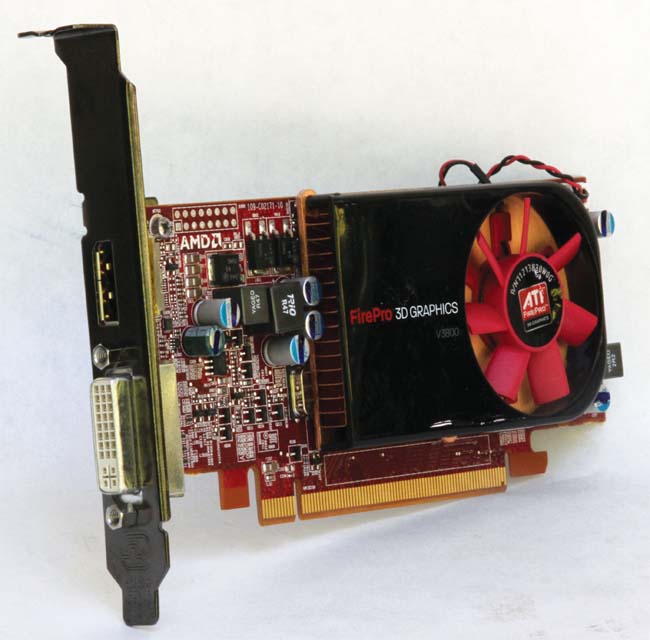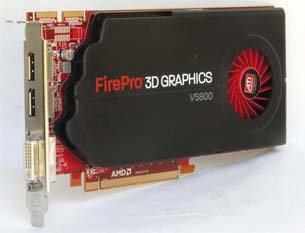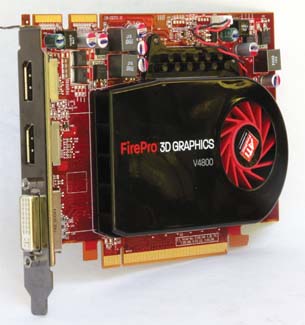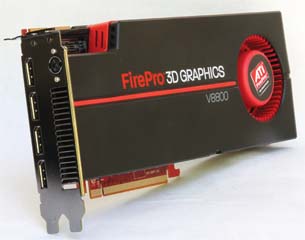Graphics Power Bonanza
AMD updates its ATI FirePro V-series lineup, doubling memory and GPU power.
December 4, 2001
By David Cohn
Each year, graphics board manufacturers introduce a new generation of workstation-class graphics accelerators, leapfrogging their previous offerings with greater power and performance. This year is no different, with AMD releasing a complete refresh of its ATI FirePro family, offering CAD and digital content creators advances in performance and features at every price point. And as is true every year, our tests show that the new boards provide better performance than last year’s boards at equal or lower prices.
 The entry-level ATI FirePro V3800. Photo by David Cohn |
All five of the new ATI FirePro V-series graphics accelerators—the V3800, V4800, V5800, V7800, and V8800—use a PCI Express 2.0 x16 bus interface and feature a full 30-bit display pipeline, enabling more color values than 24-bit boards for more accurate color reproduction and improved visual fidelity. All also support DirectX 11 and OpenGL 3.2 as well as Full Shader Model 5.0. All five boards also support multiple monitors, with all but the entry-level V3800 also supporting ATI’s Eyefinity technology, which enables users to run up to four independent and simultaneous displays with a single graphics card. With Eyefinity, you can have different applications open on each screen or span an image across multiple displays as one desktop workspace.
 The ATI FirePro V5800 balances price and performance. Photo by David Cohn |
But the biggest differences from the previous generation of FirePro boards are the amount and speed of memory and computational power in each card’s graphics processing unit (GPU). Until a few years ago, GPUs relied on dedicated geometry engines and pixel shaders. That all changed with the introduction of unified graphic architectures in which the power of the GPU can be dynamically allocated to vertex or pixel shading. AMD calls its unified shader architecture Stream processors, and the new generation of FirePro boards feature 400 Stream processors in the entry-level V3800 (up from a mere 40 in the previous generation V3700) up to a whopping 1,600 Stream processors in the top-of-the-line FirePro V8800 (twice that of the previous generation V8700).
Like their predecessors, the new ATI FirePro V-series graphics accelerators include AMD’s AutoDetect feature, which optimizes the graphics driver based on the user’s specific software applications even while running multiple programs simultaneously. With AutoDetect, users no longer need to manually adjust application-specific driver settings to achieve top performance.
With the exception of the V3800 and V8800, all of the new FirePro boards include a single DVII dual-link output and a pair of DisplayPort (DP) connectors. The entry-level V3800 includes only one of each while the high-end V8800 sports four DP ports but no DVII connection.
 The V4800 has 1GB of GDDR5 memory. Photo by David Cohn |
The New ATI FirePro V Family
At the entry-level, the new FirePro V3800 ($109 manufacturer’s suggested retail price) provides 512MB of GDDR3 memory, double that of last year’s V3700, and 400 unified shaders, 10 time that of its predecessor. Its 64-bit memory interface and 14.4 GB/second memory bandwidth are essentially the same as last year’s board, but the extra memory and more powerful GPU result in a significant increase in performance—ATI claims up to 10X performance gain—while entering the market at just $10 more than the card it replaces. The FirePro V3800 requires a single PCIe x16 slot and consumes 43 watts of power. Although AMD can no longer claim to offer an entry-level 3D graphics board for under $100, the V3800 packs a lot of power in a very small package.
While the V3800’s price makes it incredibly attractive, those looking for an entry-level workstation-class graphics accelerator can get a lot more bang for their buck by going with the FirePro V4800 ($189 MSRP/$168 street). Also billed as an entry-level board, the V4800 replaces last year’s V3750 at a slightly lower price. Although its GPU provides the same number of Stream processors as the V3800, the V4800 comes with 1GB of fast GDDR5 memory, compared to just 256MB of GDDR3 memory in last year’s V3750. The new board has the same 128-bit memory interface and 24.4 GB/second memory bandwidth as last year’s board, but again the improved GPU and larger memory yield a significant performance improvement. The FirePro V4800 also includes both a dual-link DVII connector and a pair of DP ports and supports ATI’s Eyefinity multi-display technology.
At the mid-range, AMD replaced last year’s V5700 with the new FirePro V5800. The mid-range always seems to be the sweet spot in the lineup, and that proves true again this year. With a suggested retail price of $469 ($403 average street price), the V5800 is priced more than $100 lower than the board it replaces. Although it requires just a single PCIe x16 slot, the V5800 comes with 1GB of GDDR5 memory (double that of last year’s card) and its GPU now contains 800 Stream processors (compared to 320 in the V5700). Its 64 GB/second memory bandwidth is also significantly faster than its predecessor. Like all of the new boards, the increase in power does come at the expense of greater power requirement, with the V5800 consuming 74 watts, but that’s still below the threshold at which supplemental power is required, so the V5800 should be at home in any workstation. Like the V4800, the V5800 provides one dual-link DVII output and a pair of DP connections. The V5800 also supports ATI Crossfire Pro, which enables users to harness the power of two GPUs by linking two identical FirePro cards together with the supplied connection cable.
At the high-end, AMD introduced two new boards. The FirePro V7800 ($799 MSRP, $651 street) replaces the V7750, which we did not review last year. The new board comes with 2GB of GDDR5 memory, double that of its predecessor, and its GPU provides a whopping 1,440 unified shader processors, compared to just 320 in last year’s board. The V7800 also supports Framelock/Genlock with the addition of a FirePro S400 Synchronization Module. AMD claims up to a 4.5X performance improvement over the prior generation. But while the V7800 requires just one slot, the extra power comes at a cost: the V7800 consumes 138 watts and therefore requires an auxiliary connection to the system power supply.
 The high-end V8800 takes up two slots and requires 208 watts. Photo by David Cohn |
At the top of the new AMD lineup is the FirePro V8800. Although priced at $1,499 (the same as the V8700 that it replaces), its average street price of $1,186 is a bit lower than last year’s card. The V8800 comes with 2GB of DDR5 memory, double that of the previous board. Its GPU also ups the ante, with an incredible 1,600 Stream processors, again double that of the board it replaces. Of course, its power requirements are also significant: 208 watts. Its two required auxiliary connections to the system power supply means that it can only be installed in a workstation that can supply the necessary juice. The V8800 is also so thick that it will cover an adjacent expansion slot. Like the V7800, the V8800 also accommodates the S400 Synchronization Module for Framelock/Genlock support, but unlike the other new boards in the 2010 FirePro lineup, the V8800 does not include any DVII connections, but instead provides four DP outputs. The V8800 comes with two DP to DVI single-link adapters as well as a CrossFire Pro connection cable. A workstation equipped with a pair of V8800 cards could power up to eight displays.
Benchmarking the Boards
We tested the five new ATI FirePro boards using the same HP xw6600 workstation equipped with a pair of 3GHz Quad-Core Xeon E5450 processors, so all of our results are directly comparable. Since the newer boards require updated versions of the ATI Catalyst driver software, we also retested last year’s boards using the updated driver to get an accurate comparison of the performance improvements.
Pricing >ATI Fire Pro V4800: $189 (suggested retail), $168 (average street) >ATI Fire Pro V5800: $469 >ATI Fire Pro V7800: $799 (suggested retail), $651 (average street) >ATI Fire Pro V8800: $1,499 (suggested retail), $1,186 (average street) |
All tests were performed using both version 10 of the SPEC Viewperf benchmark and version 11, which was recently released, both at a resolution of 1,280x1,024. See the benchmarking results here.
Our test results clearly indicate improved performance over the previous generation of FirePro graphics boards, although not the 2X to 10X gains claimed by AMD. That said, this new generation of ATI FirePro boards do indeed equal or surpass the performance of the older boards at prices often significantly lower than their predecessors. All of the new ATI FirePro boards are fully certified with most CAD sand DCC applications and use the same unified video driver. Drivers are available for most 32- and 64-bit operating systems, including Windows 7, Vista, XP, and Linux.
With these new ATI FirePro boards, the competition between AMD and NVIDIA continues, with users like you and me reaping the performance benefits.
More Info:
AMD
David Cohn is a computer consultant and technical writer based in Bellingham, WA, and has been benchmarking PCs since 1984. He’s a contributing editor to Desktop Engineering and the author of more than a dozen books. You can contact him via email at [email protected] or visit his website at www.dscohn.com
Subscribe to our FREE magazine, FREE email newsletters or both!
About the Author
David Cohn is a consultant and technical writer based in Bellingham, WA, and has been benchmarking PCs since 1984. He is a Contributing Editor to Digital Engineering, the former senior content manager at 4D Technologies, and the author of more than a dozen books. Email at [email protected] or visit his website at www.dscohn.com.
Follow DE





